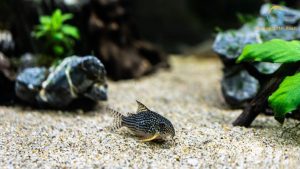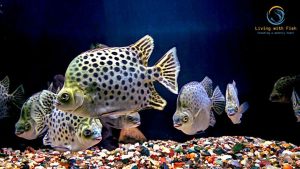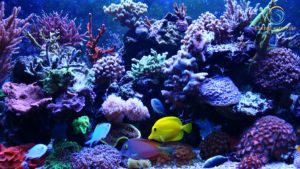This article covers the following areas –
- Why Schooling Fish Are My Favorites
- Top Schooling Fish I’ve Hosted and Loved
- Tips for Keeping Your School of Fish Happy
- In Conclusion

Whenever I find myself standing in front of an aquarium, one sight always captures my heart: a shimmering school of fish moving in unison like a living, flowing piece of art. Something is mesmerizing about the coordinated dance of schooling fish. I’ve often caught myself losing track of time, completely absorbed by their harmonious display. If you’ve ever considered introducing schooling fish to your tank, I’m here to share my experiences and top recommendations.
Schooling fish, known for synchronized swimming behaviors, create captivating aquatic displays. Popular choices include Neon Tetras, Rummy Nose Tetras, Cardinal Tetras, and Harlequin Rasboras. Their collective movement offers aesthetic appeal and mimics natural aquatic ecosystems.
To elevate your aquarium’s visual allure, delve deeper into our comprehensive guide on schooling fish. With insights into their care, behaviors, and the top species to consider, you’ll be well-equipped to curate a mesmerizing underwater spectacle.
Why Schooling Fish Are My Favorites
Every aquarium enthusiast has that one thing that truly hooks them – for some, it’s the vibrant colors; for others, it’s the tranquility the tank offers, but for me, it’s the beauty and rhythm of schooling fish. I’ve been enamored since I saw my first school of neon tetras dancing in perfect harmony.
The way they move, almost like a singular entity, strikes a chord deep within. But it’s not just their mesmerizing synchronized movements that make them my top pick; there’s more beneath the surface. Let’s dive into why schooling fish is special in my heart.
A Natural Ballet
I’ve always been a fan of nature’s performances, and in the aquatic world, the schooling fish take center stage. Like the synchronicity you’d expect in a ballet theater, these fish have mastered the art of moving in sync. Why do they do it?
It’s nature’s way of keeping them safe. Imagine being a predator and trying to pick out one fish from a shimmering group constantly moving and changing direction. Pretty daunting, right? The schooling behavior is a natural defense mechanism that helps them in the wild and gives us, the spectators, a captivating show in our living rooms.
Easy on the Stress
Do you know how humans sometimes need a company to feel at ease? Turns out certain fish feel the same way! Schooling fish are sociable by nature. In the wild, there’s safety in numbers. While there might not be predatory threats in the confines of a tank, being in a group helps them feel more secure and at home.
This social structure is vital for their well-being. When they’re together, they’re less stressed, which means they’re happier, healthier, and more active. And believe me, a happy fish is a treat to watch.
Strength in Numbers
Another fascinating thing about schooling fish is their group dynamics. It’s not just about safety or show; it’s also about communication. Through subtle changes in body posture, speed, and direction, they signal each other, helping to maintain the group’s cohesion. This intricate form of communication is another testament to their intelligence and adaptability.
Diverse Yet Unified
When you look at schooling fish, you’ll notice that while each fish might have its unique colors and patterns, they all move harmoniously. This diversity in unity is another aspect I deeply appreciate. It’s a lesson in how different individuals can come together to create something larger than themselves.
So, if you’ve ever wondered about adding a school of fish to your tank, I’d say go for it! Their natural ballet and ease of the tank environment will surely add a dimension of grace and wonder to your aquatic setup.
Top Schooling Fish I’ve Hosted and Loved

Every aquarist has tales of fish they’ve loved and cherished, and I’m no different. Over the years, I’ve played host to many finned friends, but the schooling fish have always held a special spot in my heart. Something is mesmerizing about watching them glide seamlessly, turning and dancing in harmonious patterns.
Their synchronized movements and vivid colors have brightened many a dull day for me. While countless species are out there, some schoolers graced my tanks and never failed to captivate my attention.
1. Neon Tetras
Ah, the classics! Neon Tetras have a special place in almost every aquarist’s journey. Their shimmering blue and passionate red hues make them stand out, especially when they flash around as a collective. I particularly love their modest size, allowing them to fit comfortably in various tank sizes. Given their sociable nature, getting a good group is always best – they seem happiest.
Moreover, Neon Tetras are quite adaptable. Originating from the soft, acidic waters of the Amazon, they’ve evolved to tolerate a range of water conditions in captivity. However, stability is the key; they’re not big fans of drastic changes. Another little tidbit? They’re somewhat nocturnal. Dimming the lights or adding floating plants can encourage them to be more active during daylight hours.
2. Rummy Nose Tetras
Now, these are a delight! The unique red nose, which inspired their name, is an instant attention-grabber. And their tail? The distinct stripes are a design marvel. Rummy Nose Tetras aren’t just a visual delight; they school tightly, often moving like a single entity.
But their beauty comes with a little caveat. Their vibrant red nose, while attractive, is also an indicator of their health and water quality. If that nose starts to pale, it’s a sign that something might be off in your tank. They’re like the canaries of the aquatic world! Also, they’re quite active swimmers, so they’d appreciate a longer tank to stretch their fins. These guys are also sensitive to water quality, so maintaining cleanliness is essential.
3. Cardinal Tetras
I can’t count the times they’ve been mistaken for Neon in my tank. A closer look reveals the richer, more extended red hue that runs through them. They’re serene pleasant, and their schooling behavior? Simply top-notch.
Originating from the Orinoco and Negro rivers in South America, these tetras thrive in soft, slightly acidic water. But, with consistent care, they can adapt to various water parameters. It’s fascinating to observe their behavior during feeding time.
Unlike some fish that dash for food, Cardinals approach their meal elegantly. To keep their colors vivid, it’s a good idea to diversify their diet, mixing high-quality flakes with occasional live or frozen foods. And one last thing, given their peaceful nature, they’re a fantastic choice for community tanks, harmoniously coexisting with other gentle species.
4. Harlequin Rasboras
My introduction to Harlequin Rasboras was purely serendipitous, and boy, am I grateful for that! Their beautiful golden bodies juxtaposed with that iconic black patch are nothing short of art in motion. They’re not just about the looks; their hardiness and adaptability make them perfect even for beginners.
Furthermore, Harlequin Rasboras are native to the soft, slightly acidic waters of Malaysia, Sumatra, and Thailand. If you plan to replicate their natural habitat, consider adding peat to the water or using driftwood. Another thing I’ve observed is their love for densely planted tanks. Plants provide them with hiding spots and make them feel secure. Plus, they’re super peaceful, making them ideal candidates for community aquariums.
5. Black Neon Tetras
Contrary to their name, they aren’t just a color-reversed version of the Neon Tetras. They offer a sophisticated look with a dark stripe contrasted against a silver body. They prefer dim lighting, which makes the stripe even more pronounced.
What makes them stand out further is their hardy nature. While they appreciate the comfort of soft, acidic water, Black Neons are quite forgiving and can tolerate various conditions. They’re schooling fish, so they love company, and something is mesmerizing about watching a group of them moving in synchrony. Given their calm demeanor, it’s a good idea to house them with similar placid tank mates.
6. Cherry Barbs
Their deep red coloration reminds me of ripe cherries, especially the males. Not overly large, they’re perfect for medium-sized tanks and make a delightful addition with their playful antics.
Cherry Barbs hail from the freshwater streams of Sri Lanka. Their natural environment often comprises shaded areas, thanks to dense vegetation. Replicating this with live plants can make them feel right at home. They’re also known to be quite active, zipping around the tank, so they appreciate open swimming spaces. And a little insider tip?
Their colors become even more vibrant during spawning. One caveat is that they can be a bit nippy, especially during breeding, so careful selection of tank mates is essential. Don’t let that deter you; with the right environment, these cherries will be the juicy highlight of your tank!
7. Green Neon Tetras
There’s a serene subtleness to the Green Neon Tetras. Unlike their radiant neon siblings, these Tetras sport an elegant, more muted green line gracefully stretching across their bodies. A native to South America’s soft and acidic waters, they’ve always seemed to me like little shards of reflected forest canopy darting around in the water.
Care-wise, they appreciate water conditions that mimic their natural habitat. So, while they can be slightly more demanding regarding water quality, the mesmerizing beauty they bring to a tank is more than worth the effort.
Watching these little green wonders weave through the foliage is genuinely a sight to behold if you’ve ever had a dense, planted setup. They’re social butterflies – or, should I say, social fish? So, always ensure you have a decent-sized group for them to feel at home.
8. Ember Tetras
Upon my first encounter with Ember Tetras, I was instantly reminded of little sparks dancing away from a bonfire. Their vibrant orange hue, especially pronounced against a backdrop of dark green plants, is one of nature’s own visual treats.
Native to Brazil’s clear, slow-moving waters, they bring a calm, almost soothing temperament. They’re happiest when there are plenty of hiding spots, be it dense plantations or little crevices in driftwood. And while they’re quite hardy and adaptable, remember that Embers are naturally timid.
Thus, surrounding them with rowdy tankmates might not be the best idea. Instead, a peaceful community setup lets them come out, play, and shine.
9. Glowlight Tetras
If ever there were fish that embodied the magic of twilight, it would be the Glowlight Tetras. Their slender bodies, adorned with an iridescent orange-red stripe, give the illusion of them being tiny, floating lanterns, especially in dimly lit settings.
Native to the Essequibo River in Guyana, they bring a particular softness to any aquarium. In terms of care, they’re not overly demanding. However, from my experience, a darker substrate and subdued lighting accentuate their natural colors.
They’re quite active swimmers. So, while they don’t require a massive tank, providing them ample horizontal space to dash around will keep them content. Their peaceful nature ensures they play well with most community fish, making them a staple in many of my tank setups.
10. Lambchop Rasboras
The first time I came across Lambchop Rasboras, I was momentarily puzzled by their quirky moniker. But once you spot that unmistakable, dark “chop” mark on their flanks, it all clicks into place. Hailing from the freshwaters of Thailand, these little fellas have always brought a playful vibe to my aquariums.
Their behavior is as delightful as their appearance. They tend to zigzag around in tight-knit groups, almost playing tag with one another. This active demeanor is a joy to watch and a boon for the tank’s liveliness.
As with most schooling fish, keeping them in proper groups is crucial to ensure their characteristic behaviors truly shine through. And trust me, amidst the right setting – perhaps with a gentle current and well-placed foliage – their school dynamics are nothing short of mesmerizing.
11. Scissortail Rasboras
The allure of the Scissortail Rasboras lies in their beauty and the elegance with which they navigate their aquatic realm. Their unique tail fins, resembling open scissors, provide them with a graceful flair, especially when they flutter them in unison during their synchronized swimming routines.
Originating from the waterways of Southeast Asia, these Rasboras have a penchant for open waters within the aquarium. What I’ve come to appreciate is their adaptability.
While they can acclimatize to various water conditions, a slight current makes them feel right at home, allowing those scissor-tails to dance beautifully. Pair them with other peaceful fish and have a harmonious, almost choreographed underwater ballet.
12. Diamond Tetras
Diamonds are a person’s best friend, too, especially when they come from these glistening tetras. Native to Venezuela’s freshwater bodies, Diamond Tetras are like little shards of reflective crystal, adding a shimmering aura to any tank.
Under the right lighting, each scale seems to twinkle, casting prismatic reflections. But beyond their aesthetics, they have an amicable disposition. Their social nature ensures they coexist well with other tankmates, and their schooling behavior is genuinely captivating when in groups.
Since they occasionally have a penchant for fin-nipping, pairing them with fish with shorter fins is best. A tank with Diamond Tetras is akin to having a moving mosaic of gleaming gems, making them an irresistible choice for many aquarists, myself very much included.
Incorporating schooling fish in your tank adds a dynamic, lively, and visually appealing aspect that’s hard to beat. Each species brings something new to the table with its unique colors and patterns. So, whether you’re just starting or looking to add to your existing setup, consider some of these stars; they will make your aquatic universe shine brighter!
Tips for Keeping Your School of Fish Happy

Schooling fish are like the synchronized swimmers of the aquatic world – beautiful, harmonious, and an absolute treat to watch. But just like any performance, behind the mesmerizing display is a set of needs and conditions that must be met to keep the ensemble strong.
I’ve been down this road multiple times, and trust me, while these fish aren’t divas, they do appreciate (and need!) a certain level of care. Let me share some of the golden rules I’ve learned to keep my scaly friends alive and thriving.
Group Size Matters
Have you ever felt out of place at a party? Schooling fish can relate. In the wild, these fish find safety in numbers, confusing predators with their coordinated movements. In the calm confines of our tanks, while there are no lurking predators, their instinct to stay together remains.
A solitary schooling fish, or even a tiny group, can become stressed, decreasing their health and color. So, always aim for the recommended group size – the bigger the group, the more natural and comfortable they’ll feel.
Room to Roam – Tank Size
Think of schooling fish like athletes; they love to stretch their fins! While they might be small, their love for long, coordinated swims remains the same. Keeping them in cramped quarters can hinder this natural behavior and cause stress. Always choose a tank that allows them to swim, turn, and dance freely. Remember, a spacious environment is always better than a tight one.
The Gourmet Guide – Diet
We all have our food preferences, and so do our finned pals. Different species have varying dietary needs. While some might be content with general flake food, others might need live or frozen delicacies. Spend some time researching the dietary habits of your chosen species. Ensuring they receive a balanced, nutritious diet will keep their colors vibrant and their energy levels high.
Steady Waters – Consistent Water Conditions
Fish are sensitive souls, especially when it comes to their water conditions. Fluctuating parameters like temperature, pH, and ammonia can cause unnecessary stress. Invest in a reliable water testing kit and make it a habit to check the water conditions regularly. Maintaining a stable environment goes a long way in ensuring the health and longevity of your school.
Avoiding Bullies – Tankmates Matter
It’s not just about the school but also their neighbors. While schooling fish are generally peaceful, not all fish share this sentiment. Some species might nip at their fins or even see them as a quick snack. It’s essential to ensure that their tankmates are compatible regarding temperament. A harmonious tank is a happy tank!
When you get down to it, keeping schooling fish happy revolves around understanding and respecting their natural behaviors and instincts. Provide them with the right environment, companions, and diet, and you’ll have a vibrant, active, and harmonious underwater world to enjoy daily.
In Conclusion
Diving into the world of schooling fish is an enriching experience for the aquarist and anyone who sees their synchronized ballet. With their collective grace and harmonious movement, these fish transform an ordinary tank into a living piece of art.
However, it’s vital to remember that behind this display lies a set of needs – from the right group size to the perfect tank conditions. By understanding and catering to these, you don’t just create an aquarium; you craft a thriving, vibrant ecosystem.
Whether you’re a newbie or a seasoned fish enthusiast, embracing the beauty and care of schooling, fish promises a rewarding and visually stunning journey.






